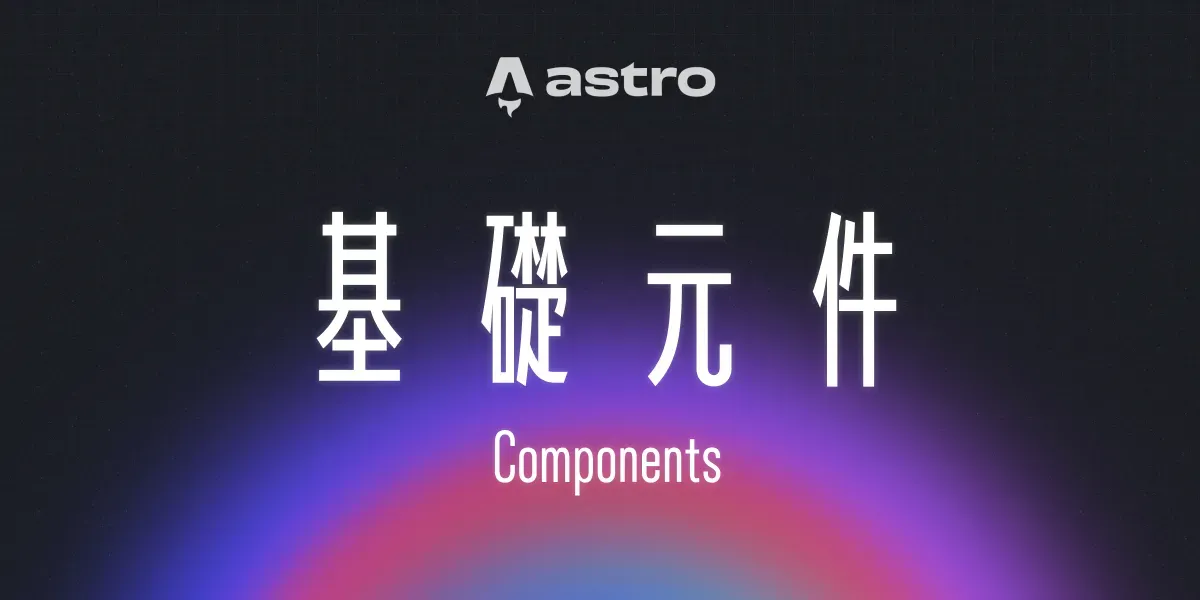
前言
前面除了創建新專案之外也了解了 Astro CLI 與設定檔的大致樣貌,本章節會從創建基本 Astro 元件開始,元件可以被放置在先前提到的 src 資料夾當中,建議創建一個 components 資料夾存放在內以方便管理。
創建元件
可以藉由創建一個副檔名為 .astro 的檔案來撰寫 Astro 元件,元件中分為腳本與模板兩個區塊,這兩個區塊由柵欄(---)所區隔。
---// 元件腳本---<!-- 元件模板 -->元件腳本代表該元件在伺服端中會被如何執行,像是你可以在這裡撰寫 JavaScript 或 TypeScript 用於:
- 引入其他 Astro 元件
- 引入不同框架的元件
- 引入與索取資料
- 接收元件接收到的資料(props)
- 創建變數並在元件模板中存取
---// 1. 導入 Astro 元件import SomeAstroComponent from './components/SomeAstroComponent.astro';
// 2. 引入不同框架的元件import SomeReactComponent from './components/SomeReactComponent.jsx';
// 3. 引入資料import pokemons from '../data/pokemon.json';
// 3. 引入資料const user = await fetch('SOME_SECRET_API_URL/users').then(r => r.json());
// 4. 透過解構獲得該元件所接收到的 propsconst { title } = Astro.props;const message = 'Astro is Awesome!'---
<!-- 5. 創建變數並在元件模板中存取 -->I think: { message }{ title }關於第 5 點,可以在伺服端 JavaScript 中創建變數使用 {} 單括弧插入到模板中,不管是屬性還是作為 Props 傳入:
---import Modal from './components/Modal.astro'const message = 'Hello Astro'---<Modal class={message} message={`${message} Here Is My Props`} />或者是撰寫 JavaScript 表達式來產生 HTML,就像是 JSX 一樣:
---const fruits = ['Apple', 'Banana', 'Cherry']---
<ul> {fruits.map(fruit => <li>{fruit}<li>)}</ul>或是選擇性的顯示模板內容:
---const isOnSale = true---
{isOnSale && <p>正在打折中!</p>}{isOnSale ? <p>正在打折中!</p> : <p>尚無打折</p>}或是動態的決定標籤種類(須留意動態標籤不支援 Hydration、並且標籤命名必須大寫,才能分辨出是原生標籤還是客製化元件):
---import MyComponent from "./MyComponent.astro";const Element = 'div'const Component = MyComponent;---
<Element>Hello!</Element> <!-- 渲染出 <div>Hello!</div> --><Component /> <!-- 渲染出 <MyComponent /> -->元件屬性 Props
可以設定讓元件接受外部傳入的屬性,只需要在元件內的伺服端腳本中從 Astro.props 中來獲得,像以下的例子 greeting 與 name 兩個變數被使用解構的方式創建出來:
---// 元件外: <GreetingHeadline greeting="Hi" name="Joe" />const { greeting, name } = Astro.props;---<h2>{greeting}, {name}!</h2>甚至可以為 Props 添加型別,讓文字編輯器可以知道「該元件應該要傳入什麼類型的東西」:
interface Props { greeting: string; name: string;}元件插槽 Slot
除了元件屬性也可以透過插槽的方式將外部的 HTML 內容傳入到元件之中,舉例來說:由於目前網站大多數頁面都包含了導覽列與頁腳元件,於是你可以創建一個名為 Base 的元件作為網頁的通用元件。
---import Navbar from '../components/Navbar.astro'import Hero from '../components/Hero.astro'import Footer from '../components/Footer.astro'---<Navbar /> <Hero /> <slot /><Footer />並且在每個頁面中引入該元件,不但可以統一管理所有頁面的架構,也不用在每一頁反覆的引入基本需要的元件。
---import Base from '../layouts/Base.astro---<Base> <!-- 此區間的模板將注入 slot 中 --></Base>具名插槽
可以擁有一個以上的插槽,這時候使用具名插槽來指定「要注入內容的插槽」。舉例來說根據先前的範例:
<Navbar /> <slot name="before-hero" /> <Hero /> <slot /><Footer />就可以使用 slot 屬性來指定想注入的插槽名稱。
<Base> <!-- 以下圖片將會注入到 before-hero 插槽中 --> <img src ="example.jpg" slot="before-hero"> <!-- 以下沒有特別註明 slot 將注入到預設 slot 中 --> <h1>你好世界</h1></Base>插槽後備方案
當在定義插槽的位址時,可以為其添加內容,這些內容就會成為當沒有任何模板傳遞進來時所採用的預設內容。
<slot> <p>這是預設後備方案,當沒有模板傳遞到 slot 時就會被採用</p></slot>插槽轉移
插槽可以被轉移到其他的元件之中,舉例來說有個元件: BaseLayout.astro
------<html lang="en"> <head> <meta charset="utf-8" /> <link rel="icon" type="image/svg+xml" href="/favicon.svg" /> <meta name="viewport" content="width=device-width" /> <meta name="generator" content={Astro.generator} /> <slot name="head"/> </head> <body> <slot /> </body></html>而它被 HomeLayout.astro 所引用:
---import BaseLayout from "./BaseLayout.astro";---
<BaseLayout> <slot name="head" slot="head"/> <slot /></BaseLayout>這時候再對 HomeLayout.astro 傳入 head 插槽將會轉移到 BaseLayout 的 head 插槽之中。
---import HomeLayout from "../layouts/HomeLayout.astro";---<HomeLayout> <title slot="head">Astro</title> <h1>Astro</h1></HomeLayout>總結
如果你先前有接觸過其他框架或 JSX 就會發現這些「元件」間的觀念都很雷同好上手,並且由於 .astro 設計主要用於伺服器渲染,因此不用擔心狀態反應性的問題,極大的刪減了複雜度!
最後會建議實際動手練習,如果過程中有問題可以參考看看我的範例:
- 在
components資料夾內撰寫像是Navbar、Footer之類常見的元件。 - 在
pages資料夾內的頁面中導入並顯示你新製作好的元件。 - 在
layouts資料夾內創建一個名為Base的元件,並且透過<slot />讓整個網站的頁面都使用該元件,甚至更進一步接受 Props 讓該元件提供更多彈性可被修改的空間(像是接受修改<head>中的meta標籤們)。 - 適當的撰寫 TypeScript 進行型別定義。
延伸閱讀
- Components - Astro DOCS
- Component Props - Astro DOCS
- Day5 - 基礎元件 - 相同文章同步發布於 iThome 鐵人賽中